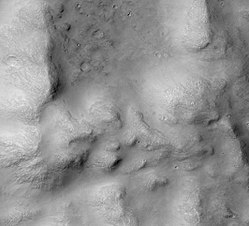Boeddicker (crater)
Appearance
 Map of Aeolis quadrangle. The Spirit Rover landed in Gusev crater. It found volcanic rocks that probably came from Apollinaris Patera. A large pile of layered rocks sits in the middle of Gale Crater. | |
| Planet | Mars |
|---|---|
| Coordinates | 15°00′S 197°42′W / 15°S 197.7°W |
| Quadrangle | Aeolis |
| Diameter | 109 km |
| Eponym | Otto Boeddicker, a German astronomer (1853-1937) |
Boeddicker is a crater in the Aeolis quadrangle of Mars, located at 15° south latitude and 197.7° west longitude. It is 109 km in diameter and was named after Otto Boeddicker, a German astronomer (1853–1937).[1][2]
Boeddicker Crater was discussed as a landing site for the 2003 Mars Exploration Rovers. It was one of 25 from a list of 185 after the FirstLanding Site Workshop for the 2003 Mars Exploration Rovers, January 24–25, 2001, at NASA Ames Research Center.[3][4][5]
Boeddicker Crater has a uniformly sloped crater floor which tracks with a gradational albedo change, similar to Gusev crater to the east. Some researchers have hypothesized that this could be the result of aeolian deposition.[6]
-
Boeddicker Crater Floor, as seen by HiRISE.
-
West side of Boeddicker Crater, as seen by CTX camera (on Mars Reconnaissance Orbiter).
-
Enlargement of previous image showing dunes on floor of Boeddicker Crater, as seen by CTX camera (on Mars Reconnaissance Orbiter).
-
A topographic map showing Boaddicker crater and the central hill which rises about 1,800 meters off the crater floor.
See also
[edit]- Groundwater on Mars
- Geology of Mars
- HiRISE
- Impact crater
- Impact event
- List of craters on Mars
- Ore resources on Mars
- Planetary nomenclature
References
[edit]- ^ "Gazetteer of Planetary Nomenclature | Boeddicker". usgs.gov. International Astronomical Union. Retrieved 4 March 2015.
- ^ "Google Mars".
- ^ Golombek M. et al. (2001) LPS XXXII, abs. #1234.
- ^ http://webgis.wr.usgs.gov/mer Archived 2016-12-08 at the Wayback Machine and http://marsoweb.nas.nasa.gov/landingsites/mer2003.
- ^ Golombek, M., J. Grant, T. Parker, T. Schofield, D. Kass, P. Knocke, R. Roncoli, N. Bridges, S. Anderson, J. Crisp, A. Haldemann, M. Adler, W. Lee, S. Squyres, R. Arvidson, M. Carr, C. Weitz. 2002. DOWNSELECTION OF LANDING SITES FOR THE MARS EXPLORATION ROVERS. Lunar and Planetary Science XXXIII 1245.pdf
- ^ Roth, LE; Saunders, RS; Downs, GS; Schubert, G. "Radar altimetry of the Martian cratered highlands". Bulletin of the American Astronomical Society. 19: 834.




